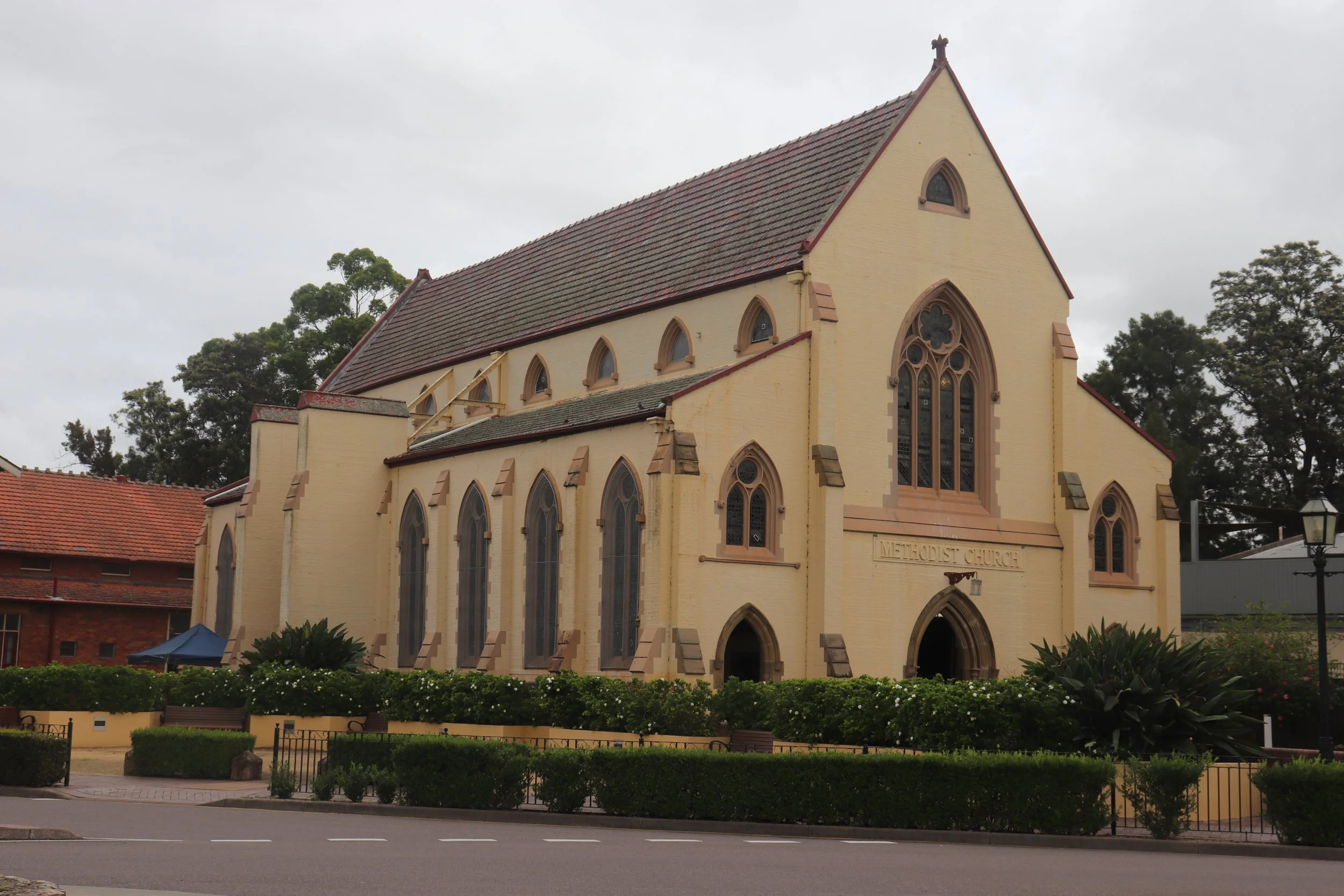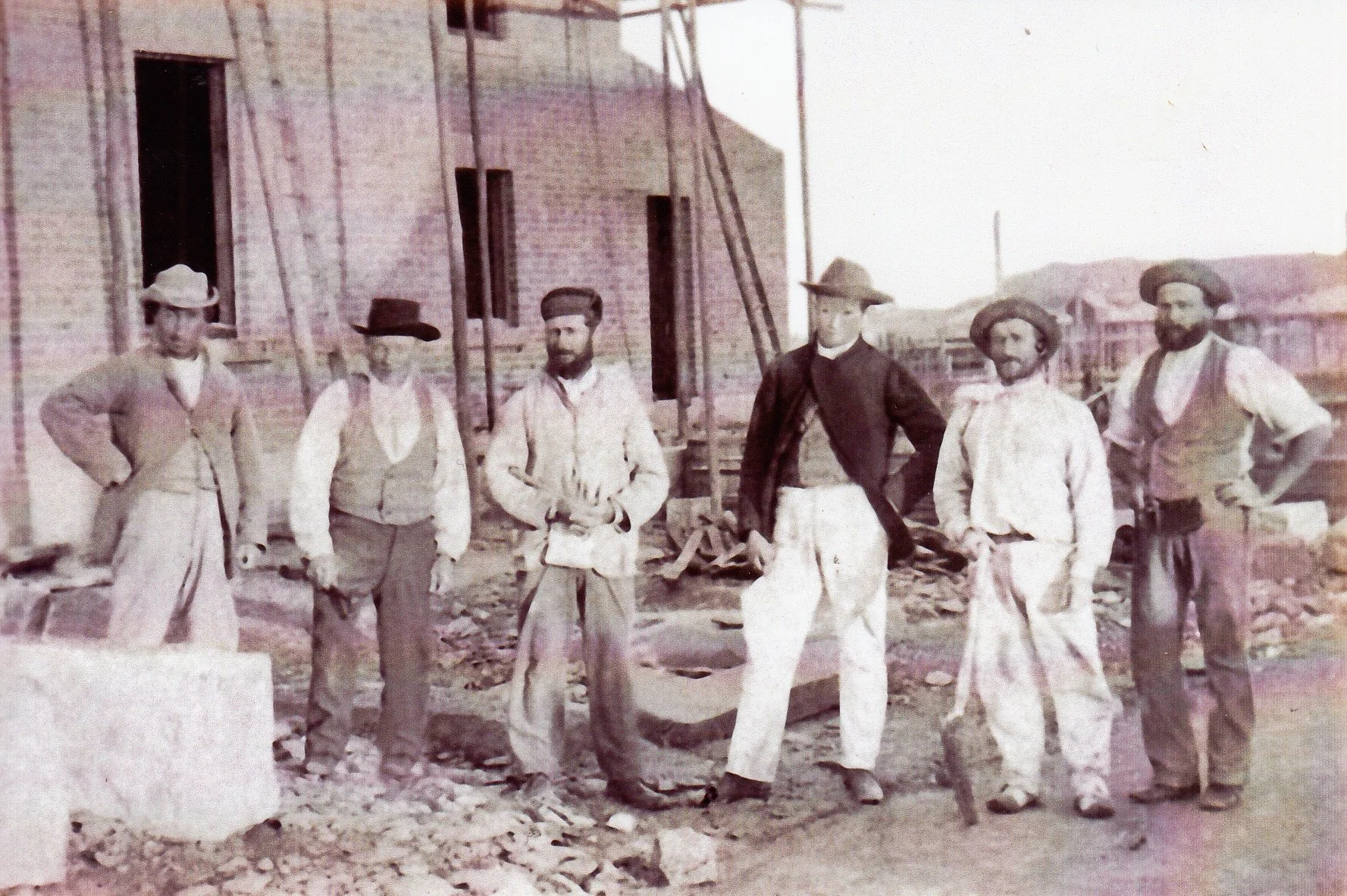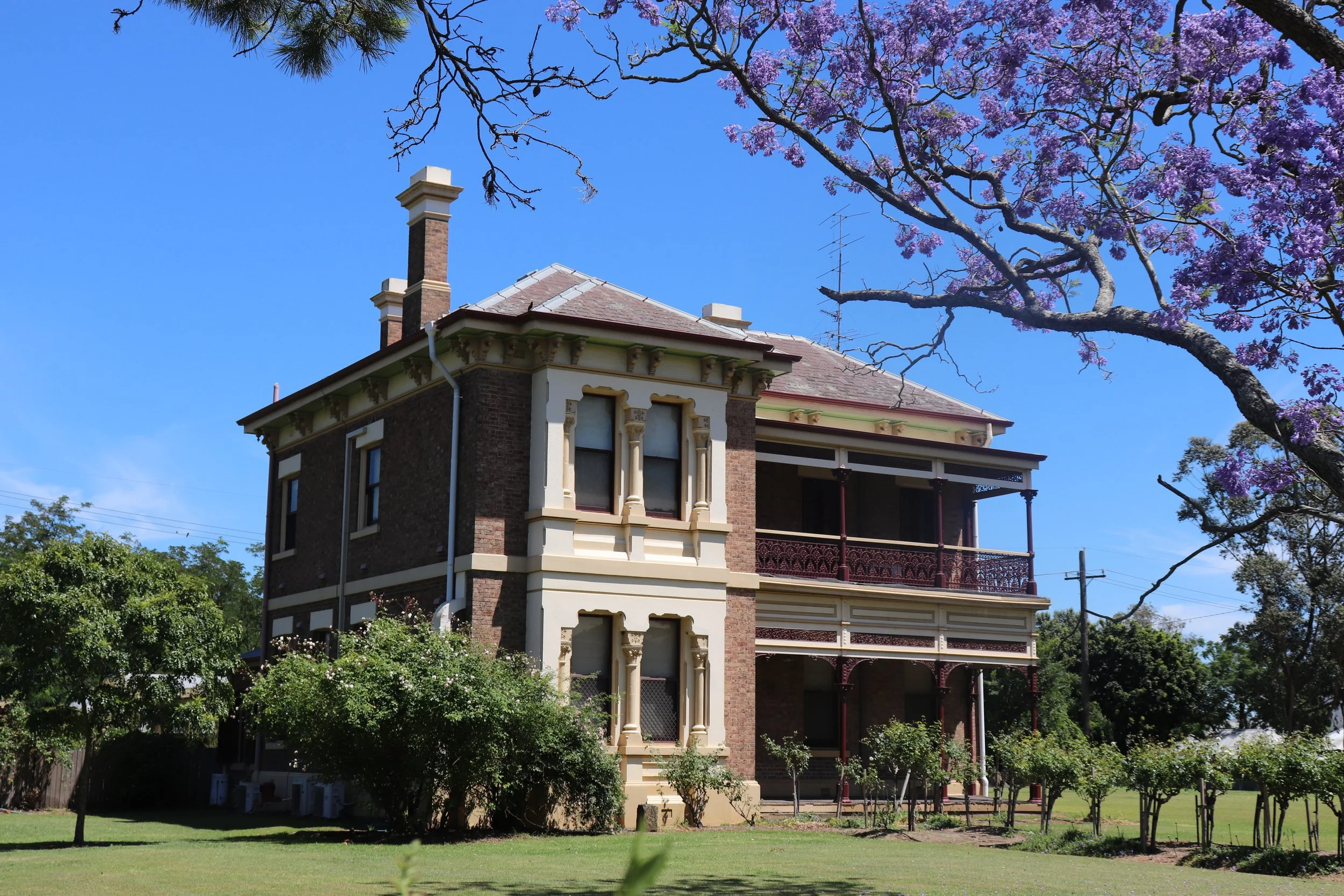John Wright
John Wright was born on 6 June 1821 at New Cross, Kent, England. He began his building career in England, as a plasterer. In February 1856, he and his wife, Harriett Rebecca, with 3 sons and a daughter left Plymouth on the Robert Small for Sydney. Soon after, the family moved to the Hunter, settling in East Maitland, where John established himself as a builder.
Harriet Rebecca and John Wright, circa 1871.
(Wright family photographs)
Builder
In 1857, soon after his arrival in the district, John Wright won the contract for ballasting the new railway line between East and West Maitland and for the erection of the railway station and goods shed at the Elgin Street crossing. He also built the station master’s cottage in Steam Street.
West Maitland Railway Station, 1877.
These contracts marked the beginning of what proved to be an impressive - if at times financially challenging - building career in the district.
In 1857 he built the Wesleyan Methodist Chapel (now the Uniting Church) in High Street, West Maitland. It was described by the Mercury as ‘Victorian Gothic style, remarkably free from ornamentation’. The building was considered to be the largest Wesleyan Chapel in the colony, at 100 feet by 53 feet (30.5 m x 6 m) and the Mercury said it was capable of accommodating 820 persons. The stonework was carried out by Messrs Mack and Sherwood. John Wright was responsible for the remainder of the building. The cost of the building was estimated to be between £5000 and £6000.
The Methodist Church (now the Uniting Church), High Street, Maitland.
(Photograph: Janece McDonald)
In 1865, with the help of his three sons, he began to build Chadlington, his own house in East Maitland. It was a substantial slate roofed brick building fronting Newcastle Street, East Maitland, on the hill between Burg and Victoria Streets. The Mercury stated that on 9 January 1866, the temperature reached 104 degrees (40 C) and ‘no less than twenty bush fires could be counted yesterday afternoon from Mr Wright's observatory, East Maitland.’ The tower of Chadlington was obviously used as an observatory.
Chadlington, the Wright family home.
(Wright family collection)
Building Chadlington
(Wright family collection)
John Wright was responsible for building a number of other constructions in the Hunter.
There was Dugald McCallum’s store in George Street, Singleton, in 1877. It was described as a large, well-built store and dwelling. The architect was J. W. Pender.
In May 1879, he built a four-roomed cottage in William Street, East Maitland, for Peter Murphy of Wallis Creek. The building was constructed of brick, on a stone foundation, with a roof of galvanised iron and was considered to be of a neat character.
In July 1880, the committee of St Mary’s Church accepted John Wright’s tender for the construction of the church’s parsonage. The tendered price was £1,411 and the work was to be completed in seven months from the signing of the contract. George Browne was the architect.
St Mary’s Rectory, Church St, Maitland, 2020.
(Photograph: Lawrence Henderson)
Since John Wright’s single storey structure, a second storey and ground floor additions have been added.
In 1881 Wright was contracted to work on the court house buildings at East Maitland to realise required alterations and additions to provide additional accommodation for jurymen and officers of the court, and separate quarters for the caretaker of the building.
East Maitland Courthouse, 2022
(Photograph: Janece McDonald)
A staunch Wesleyan
Wright was a staunch Wesleyan, and this possibly influenced his involvement in the building of the Methodist Chapel in the late 1850s.
By 25 August 1863 he is listed as a member of the church committee along with Messrs Owen, Beckett, Falkner, Blair, Youdale, Gulley and Dr Spink, with Mr Blair, treasurer and the Rev G Woolnough, secretary.
In May 1865 Wright was elected to the committee of the Wesleyan Missionary Society.
Community involvement
Alongside his involvement with and work for the Methodist Church, Wright also participated actively in a number of community organisations and institutions.
He was a foundation member of the Maitland Mechanics’ Institute, established in 1856, and at the AGM in February, 1864, was elected its Vice President. He continued serving on the committee of the Institute for many years.
He became Worthy Patriarch, Brother John Wright, at the inauguration of the Star of the East (Sons of Temperance) Division, East Maitland on 5 June 1867 and became Grand Treasurer of the Division in March 1869.
In mid-1867 he became a member of the Flood Relief Committee that was formed to alleviate the distress caused by the recent major flood, described by the Mercury as ‘a calamitous visitation’.
In March 1868 he was among local dignitaries who welcomed Prince Alfred, fourth son of Queen Victoria, at East Maitland Courthouse. He was there as the ‘Grand Treasurer’ of The Sons and Daughters of Temperance in the Hunter River district.
East Maitland Council
East Maitland was officially declared a municipality in April 1862, and nominations were called for aldermen. John Wright was put forward. He was unsuccessful at the subsequent elections.
He was again nominated in February 1863 and again was unsuccessful. His nominator, A. Dodds, described him as
“a gentleman who often attended the Council deliberations and would probably make a good member of Council although he was a little given to making long speeches. His experience also as a councillor in London would no doubt be an advantage to the town if brought to bear upon it through the Council. ”
On 18 April 1863 the Mercury reported that Wright had been appointed Overseer of Works to the Municipality of East Maitland. His appointment, however, was short lived. He was accused of interrupting the Mayor at an October Council meeting ‘in a most unwarrantable and offensive manner’ while the Mayor was reading out a surveyor’s report of Mr Mackay, the surveyor, about works proceeding in Banks Street. He was then ordered out of the Council chamber. He denied interrupting the Mayor, stating that he waited until the Mayor had finished reading the report before rising to have his say. He was suspended from his position on 28 October and dismissed at a Council meeting on 2 November. The Mayor had also dismissed the Town Clerk, Mr. Madgwick, in early October
In February 1864, on his third attempt, he was successful in gaining a seat on the East Maitland Municipal Council. He extended his thanks to ‘the electors for the high honour’ and asserted that
“It showed him that there were some in East Maitland who believed that he could be of value to them in the Municipal Council. He had strong faith in the future of East Maitland, and he would do his best to push on the car of public progress.”
Wright’s time as an alderman, however, was also short-lived. In July 1866 he was declared insolvent with debts of £1,583 and assets of only £1,438. He had to resign his seat due to his indebtedness. His bankruptcy was discharged by April, 1869. He stood for election again in January 1869, was unsuccessful, and he never regained his seat on Council.
Wright spent his later years drawing the Council’s attention to state of the footpaths and streets of East Maitland, and constantly wrote to Council suggesting improvements to the Municipality’s infrastructure and access.
John Wright’s death
John Wright died at his home on 16 May 1888. He was buried at the Glebe Cemetery in East Maitland. His death notice in The Mercury states:
“The late Mr. Wright had been a resident of East Maitland for over thirty years, where he carried on business as a builder and contractor. Many years ago he was an alderman of the Borough, and took an intelligent part in the debates of the Council. He had been ailing for some time.”
Chadlington demolished
Following Wright’s bankruptcy in 1868, Chadlington was sold and the family moved into a two storey brick house on the East Maitland side of the Victoria Bridge. Chadlington was then let to a Mr Smith, a Police Magistrate of the district. It later became a boarding school, kept by a Miss Downing. The house had been partially destroyed by a fire in about 1918. By 1929, it was in a dilapidated condition and had been the subject of an item in the building report of the East Maitland Municipal Council. Later in the year, demolition of the building began, making way for modern residential buildings.
The building had been described by the Mercury as ‘made of hand-made bricks of a bright red colour, with roof slates of an ornamental type. Large quantities of cedar were used throughout the interior. The workmanship had been excellent.’
References
Maitland Mercury and Hunter River General Advertiser, 1857-1888.
Maurine Osborn (John Wright’s great grand-daughter), personal communication, 2022.









